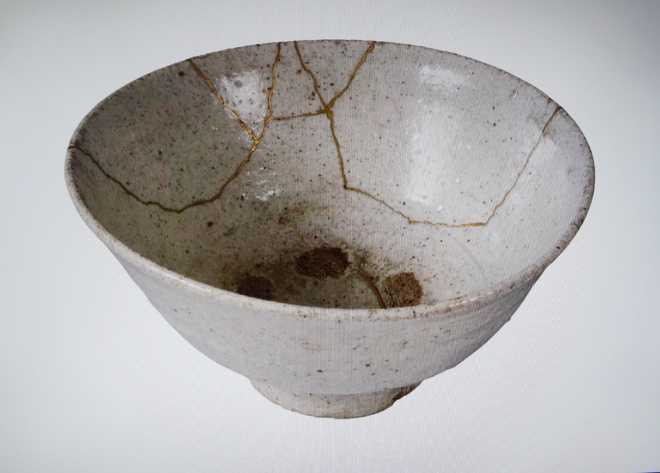
To the tea: Teabowl (chawan). 17th century, Korea. Height 3.3 inches.
BN Goswamy
Moti ho keh sheesha, jaam keh durr
jo toot gayaa, so toot gayaa
kab ashkon sey jud saktaa hai -
jo toot gayaa, so phoot gayaa.
[Be it a pearl, a mirror, or a goblet:
When it breaks, it stays broken.
How can the tears that you shed make it
whole again? Take it that it is gone forever.] — From a poem by Faiz Ahmed Faiz
Mended ceramics convey a sense of the passage of time. … simultaneously a sense of rupture and of continuity. That one moment in which the incident (of breaking) occurred is forever captured in the lines and fields of lacquer mending. Simultaneously we have the expression of frailty and of resilience, life before the incident and life after. Yet the object is not the same. In its rebirth it assumes a new identity that incorporates yet transcends the previous identity. Like the cycle of reincarnation, one life draws to a close and another begins. — Christy Bartlett
It was my friend, Caron Smith, who narrated this to us. She was at a party, thrown by Yoko Ono — gifted multi-media artist who was once the Beatle, John Lennon’s wife — in a loft, or a gallery perhaps, when, as it was ending, Yoko knowingly dropped a ceramic vase which naturally broke into several pieces. As everyone looked shaken, she — with calm, studied elegance — bent down, picked the pieces up, and distributed them among her friends, asking that they bring them back the following year when they meet again. However startled, everyone saw the happening differently. In Caron’s eyes, she told us, it was perhaps meant to convey ‘that we were all now part of something that was a whole. The possibility existed of bringing it back together, but the whole remained even though the pieces were dispersed’.
This happened years ago, in the 1970s perhaps. I heard it much later, of course, but the story, the event, had stayed with me ever since. And then, things changed for me a bit, for, against the grain of what the great Faiz wrote in his wonderful poem, I chanced to read about the exquisite art of mending. It was in an article on a conference and an exhibition that took place at the Cornell University in New York State some 10 years ago. ‘Flickwerk — The Aesthetics of Mended Japanese Ceramics’, it was titled. The same year it travelled to Munster in Germany where it was shown at the ‘Museum for Lackkunst’ run by the chemical giant, BASF, which is involved in the manufacture of lacquer, the chief material used in the mending of ceramics in Japan. Exquisite objects were shown in the exhibition and reproduced in the catalogue which also featured three delectable essays by experts. As it turns out, nearly every object was related to that great Japanese institution-cum-quiet performance: the Tea Ceremony. In the ‘Way of Tea’ — chado in Japanese — exquisite little objects naturally figured: ceramic bowls, dishes, containers, food platters, among them. An occasional object broke sometimes, even if rarely, and that is when the delicate art of mending was pressed into service. Aesthetics, never far from the Japanese mind, or sensibility, came into play. That, in essence, was the leitmotif of this exhibition and catalogue.
Delicious little stories about broken objects were woven into one of the essays, evidently to place the whole issue of breakage and repair in perspective for the likes of us. There was, thus, the story about a 16th century tea-bowl which, till now, bears the name Tsutsui Zutsu, for it has been declared as an ‘Important Cultural Property’. At its centre is this tea-bowl which belonged to a quick-tempered military general and which, during a party, fell accidentally from the hand of a servant, breaking into five pieces. Before the general could give the servant a hiding, a guest quickly composed a witty poem containing subtle references to the past and recited it aloud, thus succeeding in dissolving the tension that was threatening to ruin the event, perhaps even a life. Restored to good spirit, the general, it is recorded, forgave the servant and had the bowl restored. It has survived some five hundred years. There was also the story involving Sen no Rikyu, the 16th century master, who had the most profound influence on the Japanese tea ceremony, turning it into the exquisite art that it came to be. A person, it is said, had come to acquire a tea jar of ‘magnificent shape and glaze’ and wanted the great Rikyu to inaugurate it. Rikyu came, had tea, but did not seem to notice the jar in the slightest, and left. No words of praise had escaped his lips, seeing which, the host, bitterly disappointed, threw the jar hitting an iron trivet, breaking it. Friends, however, helped him put the pieces together with lacquer. These very friends then invited Rikyu to a gathering where the mended jar was used. As soon as the jar emerged from the cloth in which it had been kept wrapped, Rikyu burst out: ‘Now, the piece is magnificent!’
And then, in the wrapping up essay in the catalogue, there was detailed discussion on the technical aspects of mending. How lacquer is used as the principal material, what colours are mixed in it, how gold and silver powder are employed, how patches of extraneous materials are introduced. And so on. The emphasis in the whole art is not only to restore the ‘functional usefulness’ of a cherished ceramic artefact, but also on the repair to serve as ‘a medium for the artistic and aesthetic transformation of the flawed object’. The injury to the object is used as ‘the central element for the metamorphosis of the damaged ceramic’.
An afterword is introduced here. ‘As a general rule’, it says, ‘the repaired artefact acquires far higher value and enjoys greater appreciation than it had in its previously undamaged state’. Surprising? But not when you see the objects themselves: now whole again, transformed, looking past the aura of times gone by, breathing the bracing air of the present.



























